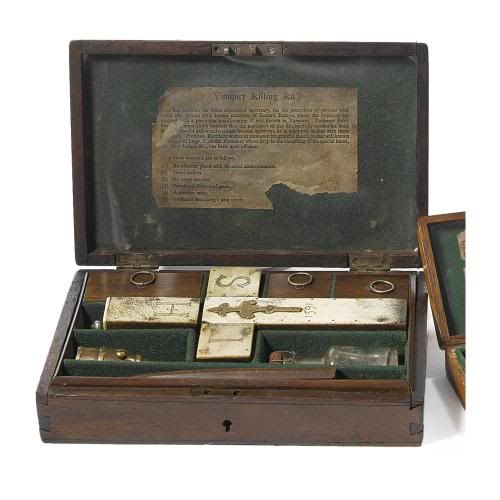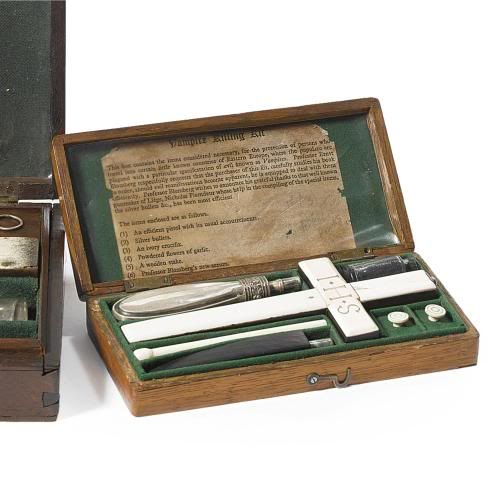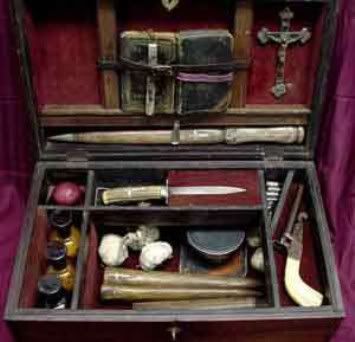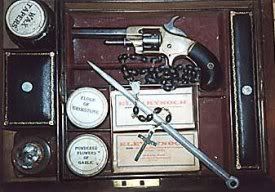From the October 24, 2008 edition of the Antique Trader:
Bidder sinks fangs into vampire killing kit for $14,850
A complete and authentic vampire killing kit – made around 1800 and complete with stakes, mirrors, a gun with silver bullets, crosses, a Bible, holy water, candles and even garlic, all housed in a handsome American walnut case with a carved cross on top – hammered for $14,850 at the Jimmy Pippen estate sale held Oct. 3-4 in the brand new Natchez Convention Center.
(.....)
The vampire killing kit probably got more attention than any other item in the sale (and it was the second such kit Stevens has sold in Natchez; the last one, in 2000, went for $7,800). But it was not the top lot of the day. That honor went to a monumental rosewood Renaissance Victorian bedroom suite, made circa 1860 and attributed to John Jelliff. The suite went to a determined bidder for $33,000.
I don't know the history of this particular example, but similar kits are sold on eBay all the time. Often, the seller claims that the kit was found near Dracula's castle in Transylvania, and the item is sold with a certificate of authenticity from Romanian authorities. Trouble is, there is no such thing as "Dracula's castle"; Bran Castle, passed off to tourists as the official "Castle Dracula", was never home to Vlad Tepes. And that just goes to show how stringent Romanian authorities are in safeguarding the authenticity of Dracula-related relics.
Furthermore, these kits usually contain a Latin inscription that includes the word nosferatu. Nosferatu is not a word in Latin or any Hungarian language. The term came to prominence due to its use in Bram Stoker's novel, and Stoker picked it up from a magazine article written by someone who didn't speak Romanian. If a similar word or phrase for vampires was in usage in Transylvania at the time, the author most likely misheard and/or misinterpreted it. Thus, an authentic kit from the 19th Century would not incorporate the word in any fashion.
Another thing to look out for is the use of screw caps for bottles, which were not invented until around 1910. This anachronism has been caught by most recent sellers, however.
Apparently, the entire phenomenon can be traced back to a London antiques dealer working the Portobello Road markets in the early 1970's. At the very least, any kit invoking the names of Professor Ernst Blomberg and gunsmith Nicholas Plomdeur are direct copies of his work, if the author is to be believed.
Of course, that is not to say that no such kits were created in Ye Olden Days. Sotheby's has listed a couple of kits with crucifix-shaped pistols, claiming a French provenance for the items dating to 1900. One of the kits sold for $12,000. The Mercer Mueseum has a kit that sounds an awful lot like the typical Blomberg set-up; according to one website, the museum originally displayed the item as an authentic 19th Century antique but now presents it as a hoax from the 1920's. In any event, even these older models were most likely manufactured and sold as novelty items and not vital equipment for actual bloodsucker-killing.


The Sotheby's Kits
As a monster hunter fan, I think these kits are pretty neat. Not $14K neat, but pretty neat nonetheless. The real thing, if it even existed, would be practical, rough-hewn, and crude. But these kits are elegant, all wood and brass and velvet sheltering patent remedies and silver talismans and Latin inscriptions. Because they are hoaxes for a modern audience, they do a far better job of exemplifying the vampire hunting kits of our imaginations.





1 comments:
Brilliant, brilliant brilliant!
I'm off to scour Portobello Road in a minute ...
Post a Comment